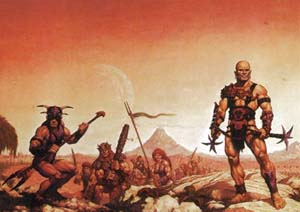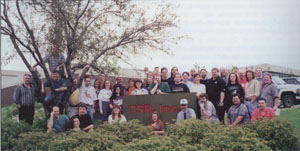By RALF TOTH
From First to Second Edition (1986 - 1990)
In 1986, Brian Blume decided to leave TSR and sell his shares to Lorraine Williams. Gygax tried to prevent this move and took the matter to court -
and lost. Tired of the battles in business and his private life (he was in the middle of a divorce), Gygax gave up and sold his shares and other interests to TSR.
The Blume-Williams deal was closed, and Lorraine Williams, grand-daughter of the man who introduced the world to Buck Rogers,
until then a complete outsider to the RPG game industry controlled the majority of the TSR shares and thus owned the company for the next twelve
years.
Another smash hit: The Forgotten Realms campaign world
After Lorraine Williams had taken over control of the company, TSR immediately started two major projects.
They acquired the rights for the campaign of a Canadian
 gamer, who had developed a massive and highly detailed fantasy campaign over the years. The gamer became lead designer
for the new campaign world - his name was Ed Greenwood (see picture) and his campaign the Forgotten Realms, was released in 1987.
It became the biggest, most successful and most popular campaign ever to be released for AD&D.
The second project involved the creation of the new edition for AD&D. Even before Unearthed Arcana was released
in 1985, there was talk of an AD&D revision. In 1986, a small design team (Steve Winter,
James M. Ward and Jon Pickens)
under the lead of David "Zeb" Cook started work on that massive project.
The idea was to write an advanced version of the game based on the 1st Edition core rules
including the Unearthed Arcana, enriched with the experience and knowledge that the years have brought.
In 1987, Lorraine Williams had eliminated TSR's debt and posted a profit of over $1,000,000.
gamer, who had developed a massive and highly detailed fantasy campaign over the years. The gamer became lead designer
for the new campaign world - his name was Ed Greenwood (see picture) and his campaign the Forgotten Realms, was released in 1987.
It became the biggest, most successful and most popular campaign ever to be released for AD&D.
The second project involved the creation of the new edition for AD&D. Even before Unearthed Arcana was released
in 1985, there was talk of an AD&D revision. In 1986, a small design team (Steve Winter,
James M. Ward and Jon Pickens)
under the lead of David "Zeb" Cook started work on that massive project.
The idea was to write an advanced version of the game based on the 1st Edition core rules
including the Unearthed Arcana, enriched with the experience and knowledge that the years have brought.
In 1987, Lorraine Williams had eliminated TSR's debt and posted a profit of over $1,000,000.
In 1988 SSI acquired the license for AD&D computer games from TSR. This company spawned a series of legendary computer games, beginning
with Pool of Radiance in 1988. The games were mostly for the Forgotten Realms and Dragonlance, but in the early
90's SSI produced games for TSR's other campaign worlds, too. All in all, SSI's AD&D computer games can be counted as among
the most successful, if not the most successful RPG games of the 80's and first part of the 90's.
Release of the Second Edition. Fantasy in Space and Gothic Horror.
In 1989 the 2nd Edition AD&D was released. TSR president Lorraine Williams praised 1989
as "a landmark year for TSR. The launch of the AD&D® 2nd Edition product line has received consumer acceptance
far beyond our wildest dreams. [...] " (from: 1990 TSR Product Catalogue) TSR states in the same catalogue, that "In the last eight months, TSR sold hundreds of thousands of AD&D® 2nd Edition
hardbound books and core products, including record-breaking numbers of Player's Handbook,
DUNGEON MASTER Guide, Monstrous Compendium etc."
The same year the fourth official campaign world was released. Jeff Grubb, co-creator of the Forgotten Realms
 wrote a bizarre "fantasy in space" campaign, with ships flying through crystal spheres and beyond,
into the Phlogiston - the Spelljammer campaign was born. The concept was to link the three existing campaigns and
fuel the sales for Greyhawk, Dragonlance and the Forgotten Realms. It remains questionable, whether the
concept worked out - four years later, Spelljammer was discontinued.
More successful was Ravenloft, released in 1990. Based on Tracey Hickman's hit module I6 - Ravenloft
of 1983, lead designer Bruce Nesmith was to write a gothic horror campaign to secure TSR's market shares in the yet untouched
horror segment. TSR continued to release material and even after it was taken over,
more Ravenloft material was released for AD&D. The campaign world still exists today.
wrote a bizarre "fantasy in space" campaign, with ships flying through crystal spheres and beyond,
into the Phlogiston - the Spelljammer campaign was born. The concept was to link the three existing campaigns and
fuel the sales for Greyhawk, Dragonlance and the Forgotten Realms. It remains questionable, whether the
concept worked out - four years later, Spelljammer was discontinued.
More successful was Ravenloft, released in 1990. Based on Tracey Hickman's hit module I6 - Ravenloft
of 1983, lead designer Bruce Nesmith was to write a gothic horror campaign to secure TSR's market shares in the yet untouched
horror segment. TSR continued to release material and even after it was taken over,
more Ravenloft material was released for AD&D. The campaign world still exists today.
Second Edition in Full Bloom. More Campaign Worlds. (1991 - 1994)
TSR now released a new campaign world every year. In 1991, it was Dark Sun, Tim Brown's award-winning
concept of a harsh desert planet ruled by sorcerer-kings. In Dark Sun nothing was as in other campaign worlds. The cute halflings
were turned into monstrous cannibals, the use of magic would be defiling the earth and priests worshipped elemental or the sorcerer-kings and not
 gods. The intriguing, high-powered concept was a major success at first. However, the line would be discontinued in 1997, during the general decline of AD&D.
That same year, TSR released a new version of the basic D&D rules, another successful new release.
In 1992 yet another campaign world was released, the oriental Al-Qadim, again written by Jeff Grubb. Officially set on Toril, the
world of the Forgotten Realms and thus closely tied to this smash hit, Al-Qadim was expected to generate considerable sales. What happened was,
the campaign utterly failed in attracting gamers and only two years later it was discontinued. In reverence, RPGA published another small adventure in 1998.
The last glorious year in the great history of AD&D was 1994. It was crowned by the release of
Planescape, a campaign world based on Jeff Grubb's Manual of the Planes from 1987.
The concept was to leave the existing campaign worlds behind, in fact, to leave the prime material planes and
enter the astral, the ethereal, the elementals and the outer planes. A campaign filled with the mightiest of all creatures,
high-powered magic and virtually endless possibilities, Planescape acquired a solid and devoting fan base.
Today, Planescape items are the most expensive of all 2nd Edition materials to acquire and they are still high in demand.
However, Wizards of the Coast decided in 1998 to discontinue the line due to a sluggish sales performance.
gods. The intriguing, high-powered concept was a major success at first. However, the line would be discontinued in 1997, during the general decline of AD&D.
That same year, TSR released a new version of the basic D&D rules, another successful new release.
In 1992 yet another campaign world was released, the oriental Al-Qadim, again written by Jeff Grubb. Officially set on Toril, the
world of the Forgotten Realms and thus closely tied to this smash hit, Al-Qadim was expected to generate considerable sales. What happened was,
the campaign utterly failed in attracting gamers and only two years later it was discontinued. In reverence, RPGA published another small adventure in 1998.
The last glorious year in the great history of AD&D was 1994. It was crowned by the release of
Planescape, a campaign world based on Jeff Grubb's Manual of the Planes from 1987.
The concept was to leave the existing campaign worlds behind, in fact, to leave the prime material planes and
enter the astral, the ethereal, the elementals and the outer planes. A campaign filled with the mightiest of all creatures,
high-powered magic and virtually endless possibilities, Planescape acquired a solid and devoting fan base.
Today, Planescape items are the most expensive of all 2nd Edition materials to acquire and they are still high in demand.
However, Wizards of the Coast decided in 1998 to discontinue the line due to a sluggish sales performance.
Decline. Card games take over. (1995 / 1996)
Sales for RPGs ware rapidly decreasing and people turned towards collectible card games, such as WOTC's Magic: The Gathering.
TSR surely felt the decrease in sales and in recognition of WOTC's megahit released their own card game (Spellfire, 1994). The game flopped
and TSR felt the financial pressure as they rapidly acquired debts.
TSR's next answer to Magic the Gathering was the beginning of the end: The Dragon Dice game burned vast amounts of cash and
TSR tried to fuel the sales for AD&D with the release of new hardcover core rule material. The PLAYER'S OPTIONS rulebooks found their way into the stores in 1995,
as did yet another new campaign world, Birthright. The concept of this new campaign was to mix roleplaying and
 strategic gaming - each gamer played a king in its own kingdom. The interesting concept failed, sales were weak and TSR continued to lose money. Meanwhile, many fans complained about the low quality of too many releases.
strategic gaming - each gamer played a king in its own kingdom. The interesting concept failed, sales were weak and TSR continued to lose money. Meanwhile, many fans complained about the low quality of too many releases.
The management continually ignored the customer's wishes. Many designers at TSR later stated that the management
decided what was to be released without even considering to listen to their customers or at least the game designers.
Despite massively shrunken sales and serious financial problems, TSR management displayed the arrogance of
the market leader in RPGs. In a press release as of December 1995, TSR stated that sales of RPGs had increased 20 percent in 1995.
In response to Peter Adkinson's (president of WOTC) comment, that sales in the role playing game industry had been on a steady decline,
Mrs. Williams said: "It is unfortunate that Mr. Adkison painted with such a
broad brush ... his statement in regard to TSR is completely inaccurate. [...] We wish Wizards of the Coast well as they divest role-playing
and other products from their company, however, their inability to produce
successful RPG lines does not necessarily reflect the state of the
industry -- and certainly not TSR!" In memory of the on-coming events, this remark is rather hilarious.
Nightmare on Christmas. TSR goes out of print.
Obviously, TSR management was in a state of panic at that time. In 1996, they moved the successful Dragonlance campaign from AD&D to a new and untested
RPG game (SAGA). Again, the game concept failed and many fans were lost. Then, at the end of 1996, it became
clear that TSR was in very serious trouble. Dec, 20 was known as the "Nightmare Before Christmas", because TSR laid off
a huge part of its staff. Worse yet, the release schedule became obsolete, as for nearly six months, no new products were released.
Without new products on the store shelves, TSR's cash flow vanished. TSR was unable to pay their printer. TSR, that proud company with great tradition was bankrupt.
What else but a miracle could save the company and AD&D? Continue to the last part
|